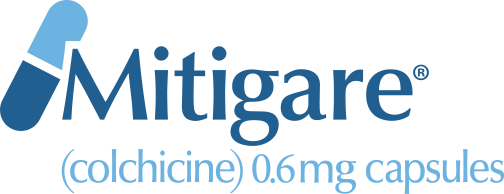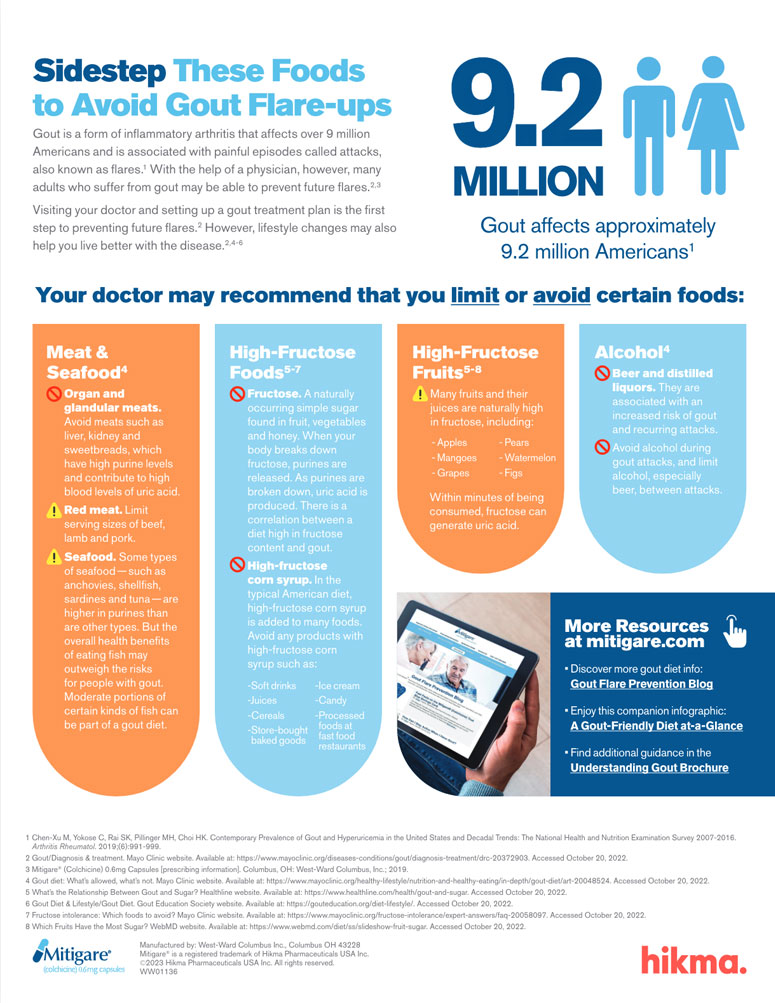
Gout is a common type of inflammatory arthritis.1,2 Painful gout flares can happen when excess uric acid in the bloodstream causes urate crystals to build up around the joints.2 Although medication is often the most effective way to prevent recurrent attacks of gout, lifestyle changes can make a difference for adults with gout, too.3 Adjusting your diet and getting regular exercise are great ways to help prevent future gout attacks.3
The impact of excess weight on gout
Higher uric acid levels are the main reason people develop gout and suffer with flares.4 When you carry extra weight, it becomes harder for your kidneys to remove excess uric acid from your body.4 In fact, a person who is considered obese is four times more likely to develop gout than someone who is of ideal body weight.5
According to Hyon Choi, MD, PhD, professor of medicine and director of the Gout and Crystal Arthropathy Center at Harvard Medical School in Boston, “There’s a very tight association between excess weight and the risk of developing gout and gout flares. It’s a dose-response relationship, meaning the more you weigh, the higher your risk, and the more likely you are to have recurrent attacks.”4
If you are overweight, gradual weight loss can help lower your uric acid levels and help reduce the risk of gout attacks.5 Small adjustments in your eating habits and moderate exercise can make a difference.6 However, attempts to speed up weight loss with crash diets and excessive amounts of exercise can lead to a serious condition called ketoacidosis.6 In addition to other health problems, ketoacidosis has been linked to gout flares.6
Exercising with gout
Be sure to talk to your doctor before you start any exercise program. Your doctor is familiar with your current health status and potential limitations and can help you determine which kinds of exercise are best for you.
Here are some other important exercise tips for people with gout:
- Do not exercise during a flare. When you are in the midst of a gout flare, reducing inflammation is the goal.7 Move the affected area as little as possible.7 You may want to apply ice for about 20 minutes at a time to reduce swelling.7
- Start slowly. If you are new to exercise, it is important to start slowly. You can start with as little as five to 10 minutes of exercise at a time and work up to 30 minutes at a time, five days a week.8
- Make it a habit. No matter what your age, health history or fitness level, it’s important to make physical activity part of your daily routine.9 There are many ways to fit a little extra exercise into your day, including9:
1. Standing up and/or walking around while you’re talking on the phone.
2. Taking a few extra trips up and down the stairs at home or at work each day.
3. Parking your car farther away rather than closer to the entrance of your workplace. (If you take the bus to work, try getting off a stop or two earlier than usual and walking the rest of the way.)
4. Doing as many errands as you can on foot instead of in the car or on the bus.
- Stay hydrated. Many dietitians recommend that people with gout drink at least 64 ounces of water each day—more if they are exercising.5 Water helps the body move nutrients and waste, enables it to maintain consistent body temperature, and cushions joints and tissues.5 Some experts believe that drinking water can also help flush uric acid out of the body.4
- Don’t get discouraged. Physical activity is important for everyone.9 If your gout limits your ability to exercise, be sure to talk with your doctor about ways you can be active in spite of these issues.
Sidestep these Foods to Avoid Gout Flare-ups
See this checklist of foods your doctor may recommend that you limit or avoid.
INFOGRAPHIC
NOTE: This article was not written by a medical professional and is not intended to substitute for the guidance of a physician. These are not West-Ward’s recommendations for gout flare prevention, but rather facts and data collected from various reliable medical sources. For a full list of resources and their attributing links, see below.

